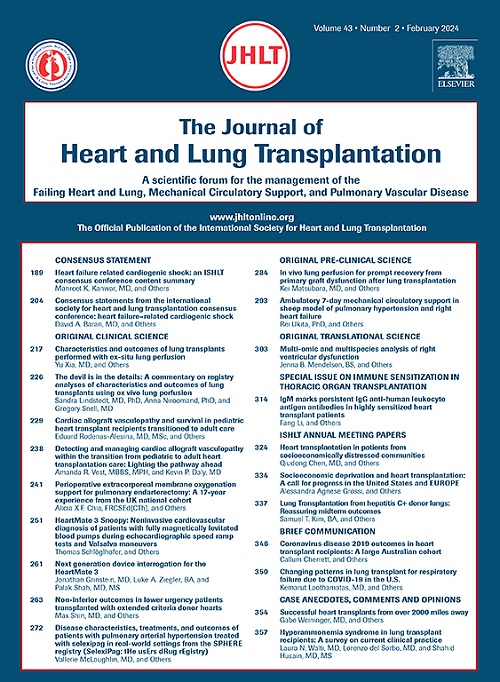体外灌注心脏移植在全国的应用及效果。
IF 6
1区 医学
Q1 CARDIAC & CARDIOVASCULAR SYSTEMS
引用次数: 0
摘要
近年来,美国越来越多地采用机器灌注(MP)进行心脏移植。然而,缺乏关于这种做法的利用和结果的务实的国家研究。方法纳入美国器官共享网络数据库中2018年10月18日至2023年9月30日期间移植的成人(≥18岁)心脏受者。我们比较了脑死亡(DBD)和循环死亡(DCD)供者的骨髓移植和非骨髓移植的结果。我们使用Cox回归评估移植后30天和1年的生存率。结果13500例DBD移植中,有403例(3.0%)采用了MP。与非骨髓移植相比,骨髓移植的供体年龄更大(34岁对32岁,p=0.003),到达受体中心的距离更远(478海里对228海里,p<0.001)。与非MP DBD移植相比,MP DBD移植的受者在出院前透析(aOR 1.33 [95%-CI: 1.01-1.75], p=0.04)和出院前卒中(aOR 1.66 [95%-CI: 1.08-2.55], p=0.02)的风险增加,但在30天(aHR 1.01 [95%-CI: 0.54-1.86], p=0.99)和1年内(aHR 0.98 [95%-CI: 0.66-1.43], p=0.90)的死亡率风险相似。976例DCD移植中,633例(64.9%)采用MP。MP与非MP DCD移植的受者有相似的透析风险(aOR 1.19 [95% CI: 0.82-1.72], p=0.36)和卒中风险(aOR 1.68 [95% CI: 0.82-3.49], p=0.16),以及相似的30天风险(aHR 1.62 [95% CI: 0.67-3.94], p=0.28)和1年死亡率(aHR 0.91 [95% CI: 0.54-1.54], p=0.73)。结论:smp在心脏移植中的使用与良好的预后相关,表明它有可能增加供体心脏的利用率,特别是对于预计缺血时间较长的供体。本文章由计算机程序翻译,如有差异,请以英文原文为准。
National utilization and outcomes of heart transplantation using ex situ machine perfusion
Background
In recent years, machine perfusion (MP) for heart transplantation has been increasingly adopted in the United States. However, pragmatic national studies on the utilization and outcomes of this practice are lacking.
Methods
Adult (≥18 years) heart recipients transplanted between October 18, 2018 and September 30, 2023 in the United Network for Organ Sharing database were included. We compared outcomes of MP and non-MP transplants among donation after brain death (DBD) and circulatory death (DCD) donors. We used Cox regression to evaluate survival at 30 days and 1 year post-transplant.
Results
Of 13,500 DBD transplants, 403 (3.0%) utilized MP. Donors of MP vs non-MP grafts were older (34 vs 32 years, p = 0.003) and traveled longer distances to the recipient center (478 vs 228 nautical miles, p < 0.001). Recipients of MP vs non-MP DBD grafts had increased risk of predischarge dialysis (adjusted odds ratio (aOR) 1.33 [95% confidence interval (CI): 1.01-1.75], p = 0.04) and predischarge stroke (aOR 1.66 [95% CI: 1.08-2.55], p = 0.02), but similar hazards of mortality at 30 days (adjusted hazard ratio (aHR) 1.01 [95% CI: 0.54-1.86], p = 0.99) and 1 year (aHR 0.98 [95% CI: 0.66-1.43], p = 0.90). Of 976 DCD transplants, 633 (64.9%) utilized MP. Recipients of MP vs non-MP DCD grafts had similar risks of dialysis (aOR 1.19 [95% CI: 0.82-1.72], p = 0.36) and stroke (aOR 1.68 [95% CI: 0.82-3.49, p = 0.16), and similar hazard of 30-day (aHR 1.62 [95% CI: 0.67-3.94], p = 0.28), and 1-year mortality (aHR 0.91 [95% CI: 0.54-1.54], p = 0.73).
Conclusions
MP use in heart transplantation was associated with favorable outcomes, suggesting it has the potential to increase donor heart utilization, particularly for donors with long projected ischemic times.
求助全文
通过发布文献求助,成功后即可免费获取论文全文。
去求助
来源期刊
CiteScore
10.10
自引率
6.70%
发文量
1667
审稿时长
69 days
期刊介绍:
The Journal of Heart and Lung Transplantation, the official publication of the International Society for Heart and Lung Transplantation, brings readers essential scholarly and timely information in the field of cardio-pulmonary transplantation, mechanical and biological support of the failing heart, advanced lung disease (including pulmonary vascular disease) and cell replacement therapy. Importantly, the journal also serves as a medium of communication of pre-clinical sciences in all these rapidly expanding areas.

 求助内容:
求助内容: 应助结果提醒方式:
应助结果提醒方式:


